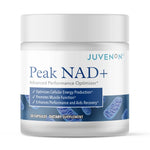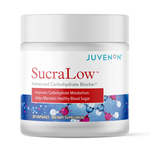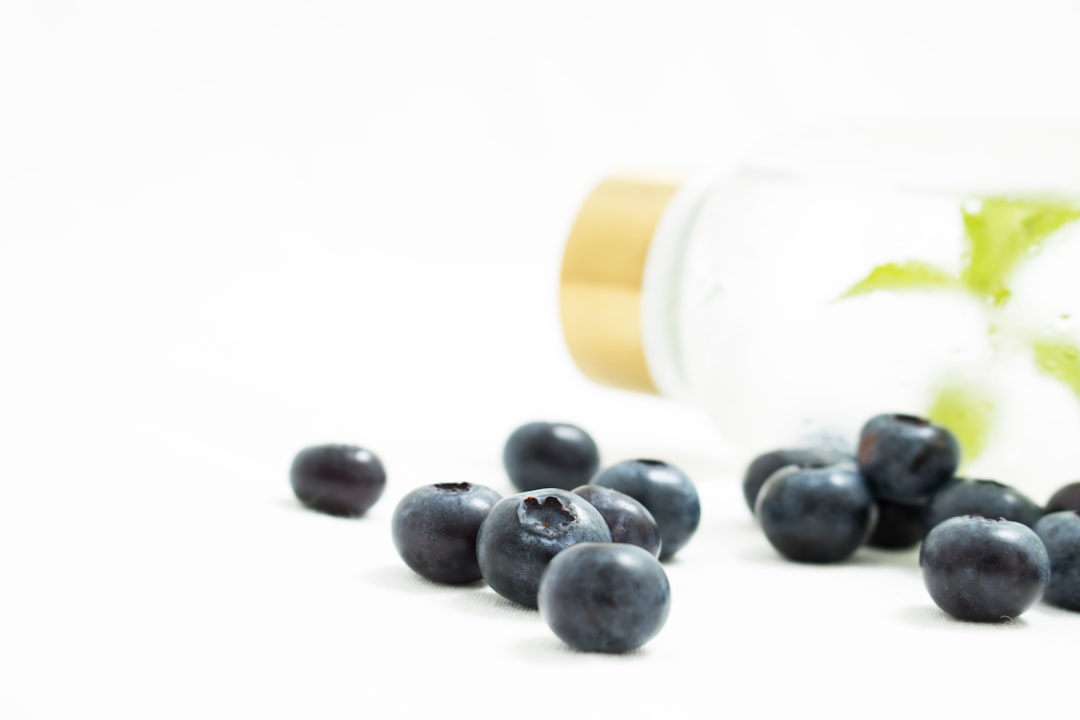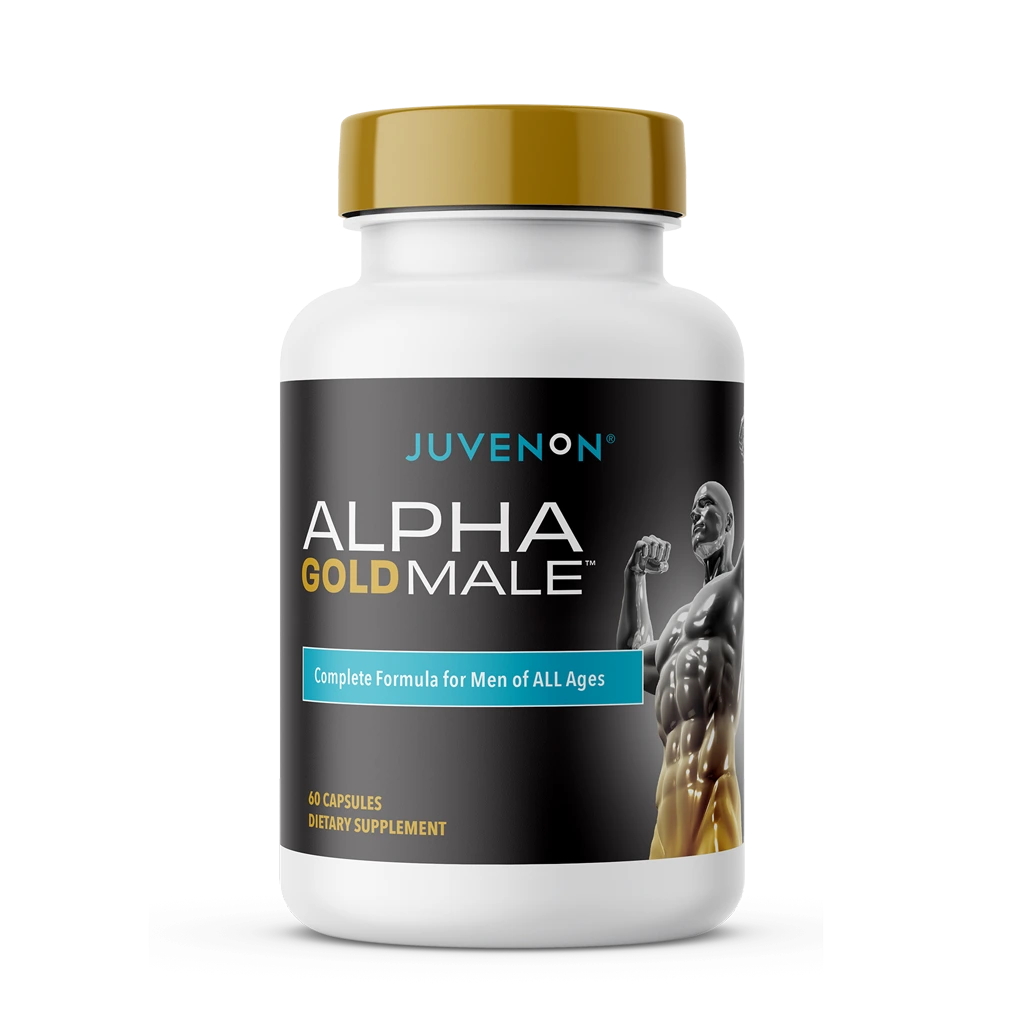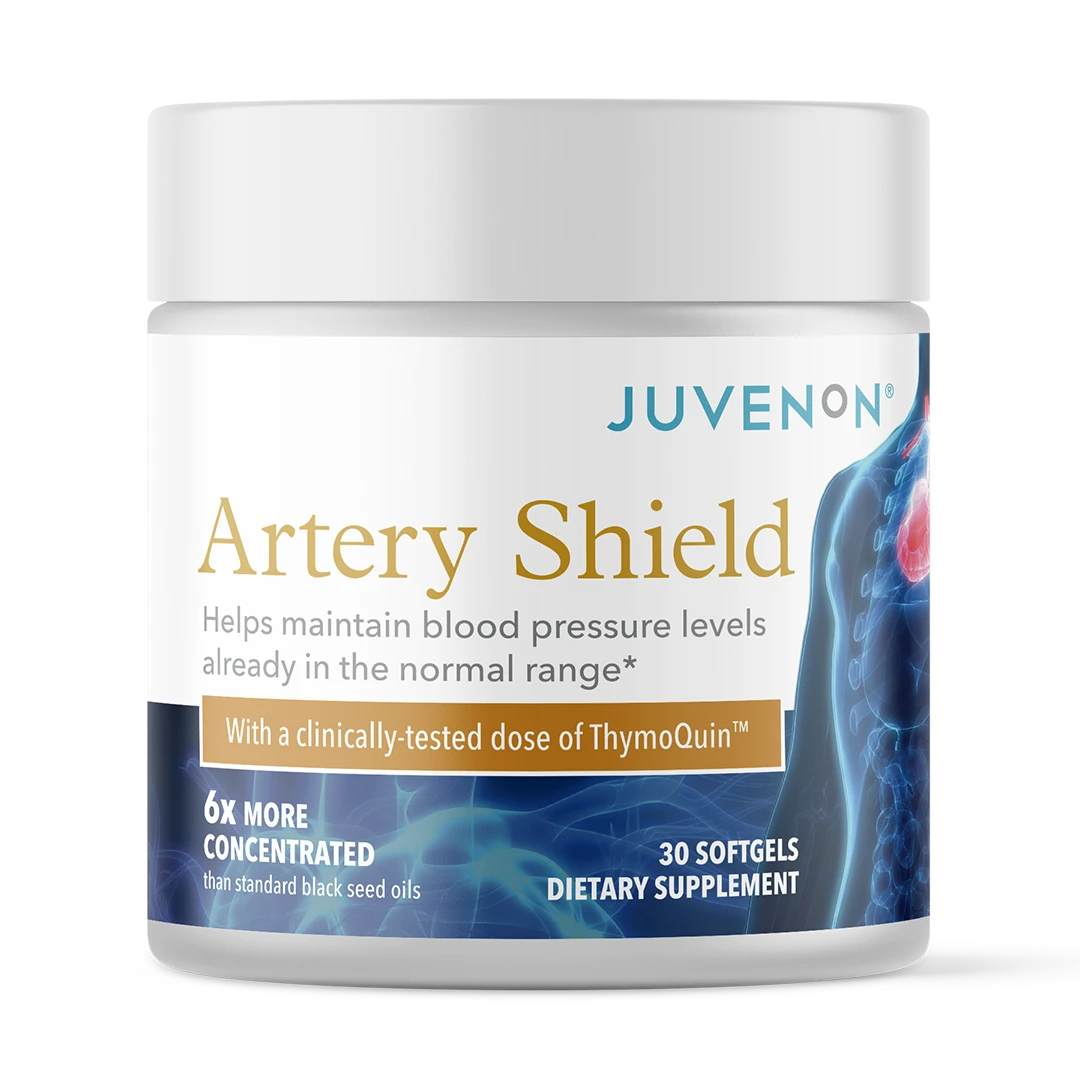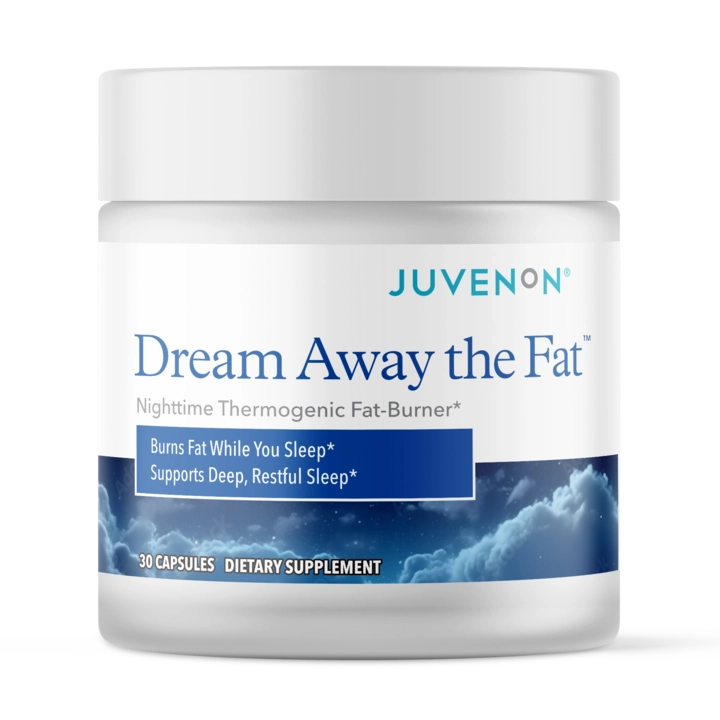Why Long Term Joint Health Starts Today
Long term joint health depends on proactive habits you develop starting today, not reactive treatments you seek after pain begins. Your joints face decades of wear and tear, but the right strategies can keep you moving pain-free well into your later years.
Key strategies for lifelong joint health:
- Weight management - Every pound lost reduces knee pressure by 4 pounds
- Regular low-impact exercise - Swimming, cycling, and walking strengthen supporting muscles
- Anti-inflammatory nutrition - Mediterranean diet rich in omega-3s and antioxidants
- Injury prevention - Proper warm-up, protective gear, and good body mechanics
- Early intervention - Address stiffness and minor pain before they become major problems
Research shows that moderate to strenuous exercise in healthy joints doesn't substantially increase arthritis risk. The real danger comes from inactivity, excess weight, and untreated injuries.
Osteoarthritis affects millions after age 45, but here's the encouraging news: most joint problems are preventable with the right approach.
As Michelle M. Henson, I've spent over two decades researching and writing about healthy aging, including the critical role of long term joint health in maintaining vitality as we age.
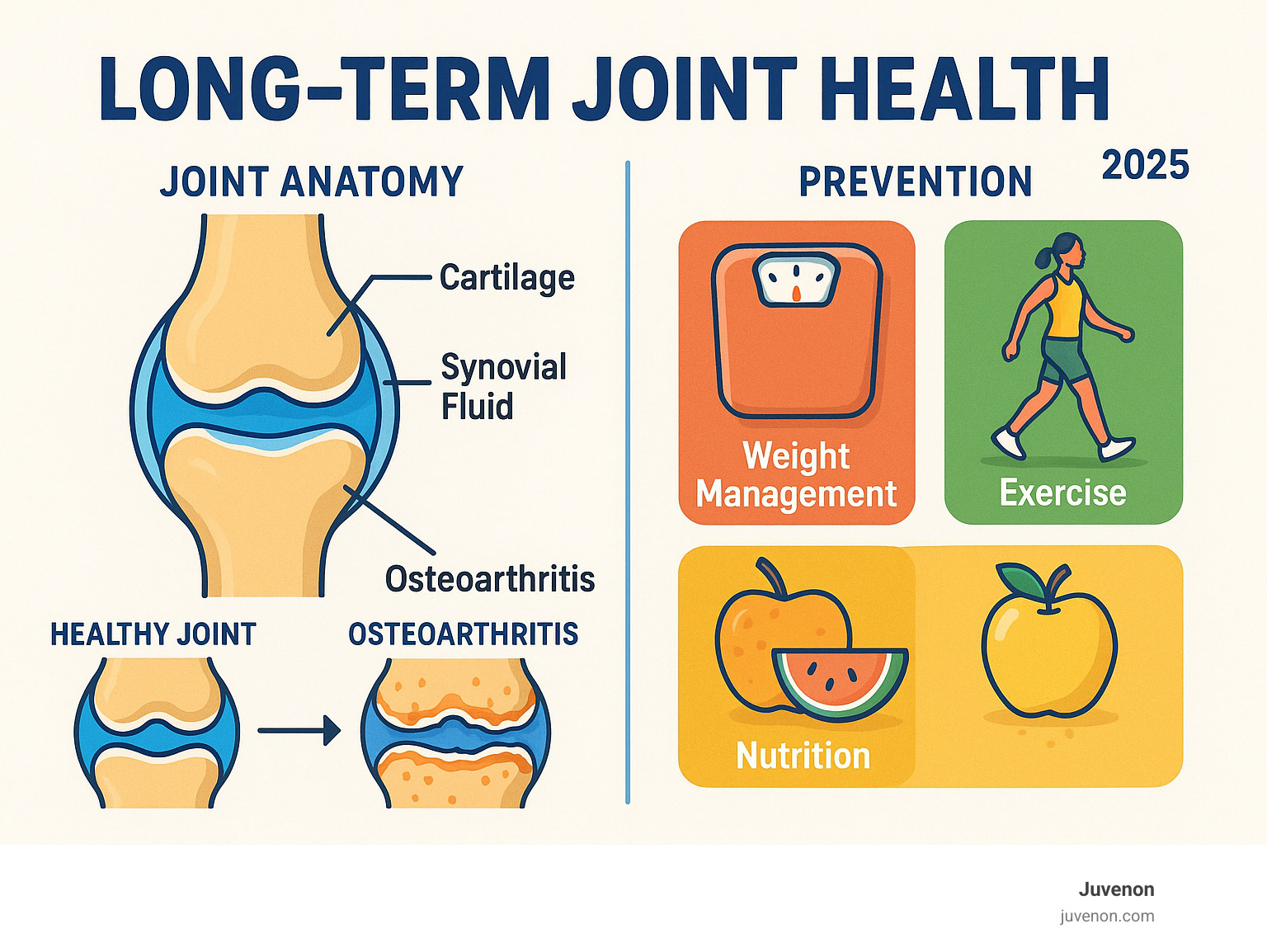
Understanding Joint Anatomy, Aging & Disease
Your joints are engineering marvels where two or more bones meet. Cartilage acts like a smooth, slippery cushion covering the bone ends, while synovial fluid lubricates everything like high-quality oil in a well-tuned engine. Just walking puts pressure equal to 1.5 times your body weight on your knees.
Cartilage is roughly 80% water and contains specialized cells called chondrocytes that maintain the tissue's structure. Unlike a cut on your skin that heals quickly, cartilage has no direct blood supply. It relies entirely on joint movement to pump nutrients in and waste products out - which is why staying active is so crucial for long term joint health.
The aging process brings predictable changes. Cartilage gradually becomes less elastic and more prone to tiny cracks. Your body may produce less synovial fluid, reducing that vital lubrication. The muscles, ligaments, and tendons supporting your joints lose some strength and flexibility over time.
These natural changes explain why joint problems typically emerge after age 45. But here's the encouraging truth: aging doesn't make joint degeneration inevitable. The right strategies can keep your joints healthy and pain-free for decades.
The Mechanics Behind Long Term Joint Health
Research shows cartilage can handle slowly applied loads remarkably well - it's the sudden impacts that cause trouble. When forces exceed about 25 MPa (roughly 3,600 pounds per square inch), cartilage can suffer damage that might not show symptoms for months or years.
This reveals why proper warm-up and gradual loading are so important. Your muscles act as natural shock absorbers, protecting cartilage from excessive stress. When muscles are weak or tired, more force transfers directly to your joint surfaces.
The principle is simple but powerful: strong, well-conditioned muscles are your joints' best friends.
Types of Arthritis and How They Affect Joints
Osteoarthritis is the most common culprit, typically appearing after age 45. This degenerative condition gradually wears away cartilage until bones rub against each other, causing pain and stiffness.
Rheumatoid arthritis is an autoimmune disease that tricks your immune system into attacking your own joint tissues. Unlike osteoarthritis, it can strike at any age and often affects multiple joints simultaneously.
Gout results from uric acid crystals building up in joints. While gout attacks are typically intense but temporary, repeated episodes can cause permanent joint damage.
Understanding which type of arthritis you're dealing with matters because treatment approaches differ significantly. The good news? We can dramatically reduce our risk of the most common type - osteoarthritis - through smart lifestyle choices.
Risk Factors You Can Control for Long Term Joint Health
Here's the empowering truth about long term joint health: while you can't turn back the clock or rewrite your DNA, you have tremendous power over the factors that matter most for keeping your joints healthy throughout life.
Body weight stands out as the single most controllable factor affecting your joints. Every extra pound you carry translates to roughly four additional pounds of pressure on your knees when you walk. Excess body fat also produces inflammatory chemicals that can damage cartilage throughout your entire body.
Activity level plays a crucial role. Regular movement keeps cartilage healthy by pumping nutrients in and waste products out. Without movement, your joints actually deteriorate faster.
Occupational strain and repetitive movements deserve attention if your work involves heavy lifting, prolonged kneeling, or repetitive motions. You can often modify techniques, use protective equipment, or take regular breaks to reduce joint stress.
Posture and body mechanics throughout the day significantly impact joint health. Poor posture creates a cascade of compensation patterns that stress joints throughout your body.
Smoking dramatically increases arthritis risk. The chemicals in tobacco smoke trigger systemic inflammation and reduce blood flow to joint tissues. Research shows that even e-cigarette users have 81% higher rates of inflammatory arthritis.
| Factors You Can Control | Factors You Cannot Control |
|---|---|
| Body weight and fitness level | Age and gender |
| Physical activity choices | Genetics and family history |
| Occupational modifications | Previous injuries |
| Smoking cessation | Certain autoimmune conditions |
| Diet and inflammation management | Natural hormonal changes |
| Injury prevention strategies | Joint anatomy variations |
For comprehensive strategies on protecting your joints, explore our detailed guide on tips to keep joints healthy.
Early Warning Signs for Long Term Joint Health
Morning stiffness lasting more than 30 minutes may signal inflammatory arthritis. Joint swelling that persists for several days, especially with warmth or redness, suggests inflammation that needs attention.
Pay attention to gradual loss of range of motion in everyday activities. These subtle changes often precede pain and can be easier to address in early stages.
Red flag symptoms include severe joint pain with fever, joints that feel hot and appear swollen, inability to bear weight, obvious joint deformity, or numbness and tingling.
Remember: temporary discomfort after unusual activity is normal. But persistent symptoms that worsen over time or interfere with daily activities deserve professional evaluation.
Move to Improve: Exercise & Physical Activity Guide
Exercise is your joints' best friend, not their enemy. Your joints need regular movement to stay healthy and strong throughout your life. When you move regularly, you're pumping nutrients into your cartilage and keeping everything lubricated.
The magic number is 150 minutes of moderate exercise per week, plus strength training twice weekly. You can break this into bite-sized pieces - even 10-minute sessions count.
Scientists studied former athletes to understand how different sports affect joints over time. Only 3% of former shooters showed signs of osteoarthritis, compared to 14% of runners, 29% of soccer players, and 31% of weightlifters. The pattern is clear: high-impact, contact sports carry more joint risk than gentler activities.
But runners aged 50-72 had 40% higher bone density than non-runners, with no significant increase in arthritis rates. This proves that the right kind of exercise strengthens your entire musculoskeletal system without damaging healthy joints.
Best Exercises for Long Term Joint Health
Walking deserves the gold medal for joint-friendly exercise. It's weight-bearing enough to strengthen bones, low-impact enough to protect joints, and simple enough that almost anyone can do it.
Swimming and water aerobics offer cardiovascular benefits with joint protection. The water supports your body weight while providing gentle resistance for strengthening.
Cycling gives you excellent heart health benefits without pounding your joints. Whether stationary or outdoor cycling, it strengthens leg muscles while being kind to knees and hips.
Yoga and tai chi combine flexibility, balance, and gentle strengthening. These practices also help manage stress, which can contribute to inflammation throughout your body.
Resistance training with bands, light weights, or machines builds the muscle armor that protects your joints. Focus on controlled movements through your full range of motion.
Can Exercise Wear Out Joints?
Researchers had dogs run up to 40 kilometers daily for an entire year. While there were minor changes in cartilage thickness, there was no actual cartilage degeneration. The key finding? Healthy joints can handle substantial exercise without developing arthritis.
The real culprit isn't exercise - it's injury. A single knee injury increases your osteoarthritis risk by five times. This makes injury prevention far more important than limiting activity levels.
For athletes looking to maximize performance while protecting their joints, check out our guide on joint health strategies for athletes.
Protecting Joints During Workouts
Dynamic warm-up is non-negotiable. Start with 5-10 minutes of light movement to prepare your joints for action.
Proper footwear provides crucial support and shock absorption. Replace athletic shoes every 300-500 miles.
Closed-chain exercises tend to be more joint-friendly. For example, squats are generally safer for your knees than leg extension machines.
Most importantly, listen to your body. Some muscle soreness after exercise is normal, but joint pain lasting more than 48 hours suggests you've overdone it.
Eat, Drink, Supplement: Nutrition & Weight Management

What you eat can be just as powerful as exercise for protecting your long term joint health. Your diet serves two crucial roles: keeping your weight at healthy levels to reduce stress on your joints, and providing nutrients your body needs to fight inflammation and repair damaged tissues.
The Mediterranean diet consistently wins for joint protection. When you fill your plate with colorful vegetables, fresh fish, nuts, olive oil, and whole grains while cutting back on processed foods, you're giving your joints exactly what they need.
Omega-3 fatty acids work like tiny firefighters in your body, putting out the flames of inflammation before they can damage your cartilage. Try to enjoy fatty fish at least twice a week.
Antioxidants from brightly colored fruits and vegetables act like bodyguards for your cartilage. Dark berries, leafy greens, and vibrant bell peppers contain compounds that neutralize harmful molecules before they can cause joint damage.
Calcium and vitamin D work hand in hand with joint health. Strong bones provide better support for your joints, reducing wear and tear over time.
Vitamin C is essential for making collagen, the protein that gives your cartilage its bounce and flexibility. Citrus fruits, strawberries, and bell peppers support your body's natural repair processes.
For specific foods that can calm joint inflammation, check out our guide to 7 foods to reduce inflammation.
Body Weight and Knee Force: The 4-to-1 Rule
Every single pound you carry translates to about 4 pounds of pressure on your knees when you walk. If you're carrying an extra 20 pounds, that's 80 additional pounds of force hammering your knee joints with every step.
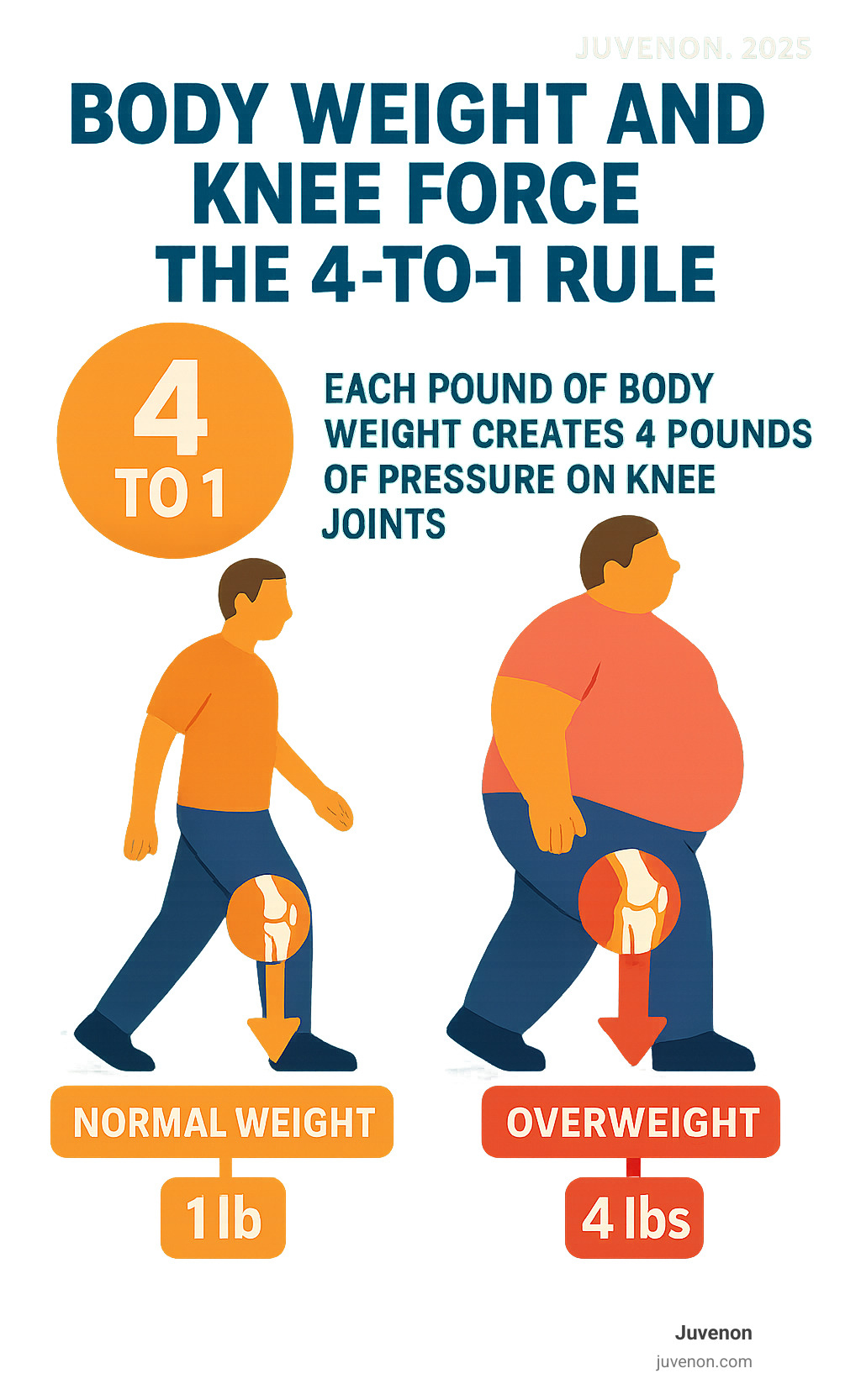
Research shows that people with knee osteoarthritis who lost 20% or more of their excess weight experienced significantly less pain and could walk much farther. But you don't need massive weight loss to see benefits. Dropping just 10 to 15 pounds can meaningfully reduce joint stress.
Supplements & Emerging Therapies for Joint Longevity
Glucosamine and chondroitin are the most researched joint supplements. While they may help some people feel more comfortable, they won't rebuild damaged cartilage or eliminate the need for other treatments if arthritis is severe.
Collagen supplements show promise for joint pain and stiffness, but we're still not sure if the collagen you swallow actually makes it to your joint tissues.
Turmeric and curcumin show real promise as natural anti-inflammatory agents. While they won't reverse existing cartilage damage, they may help keep inflammation in check.
Supplements can be a helpful part of your long term joint health strategy, but they work best when combined with proven fundamentals: regular exercise, healthy weight management, and anti-inflammatory nutrition.
Injury Management, Treatments & Adaptive Tools
How you handle joint injuries can make all the difference for your long term joint health. Quick, smart action often prevents minor injuries from becoming major problems.
The RICE protocol helps minimize damage and speed recovery. Rest gives injured tissues time to heal. Ice applied for 20 minutes several times daily reduces swelling and numbs pain. Compression with an elastic bandage controls swelling, while elevation above heart level helps fluid drain away.
If you can't bear weight on an injured joint, if it feels unstable, or if pain is severe, don't tough it out. Early professional treatment often prevents complications that could affect you for years.
Conservative treatments work well for many joint problems. Physical therapy helps restore strength and mobility. Anti-inflammatory medications can reduce pain and swelling when used appropriately. Supportive braces provide stability during healing.
For serious inflammatory conditions like rheumatoid arthritis, advanced medical treatments may be necessary. Disease-modifying drugs can slow joint damage, while newer biologic medications target specific immune pathways.
Surgical options become relevant when conservative treatments no longer provide adequate relief. Joint replacement surgery has become remarkably successful, with most people experiencing dramatic pain relief and improved function.
For insights into how your body can repair cartilage naturally, check out our guide on natural cartilage repair.
Acute Injuries and Their Long Term Joint Health Impact
Knee injuries increase your osteoarthritis risk by five times, regardless of how well you heal initially. ACL tears are particularly notorious for leading to early knee arthritis, even after successful surgical repair. Meniscus removal also significantly increases arthritis risk.
Ankle sprains might seem minor, but repeated sprains can cause chronic instability and eventual arthritis. Shoulder dislocations often lead to recurrent problems if supporting structures don't heal properly.
The takeaway isn't to avoid all physical activity. Instead, use proper technique, wear appropriate protective gear, and get prompt, thorough treatment when injuries occur.
Managing Joint Inflammation
Chronic inflammation acts like a slow fire burning in your joints, gradually damaging cartilage. You have significant control over inflammation levels through daily choices.
Heat and cold therapy provide natural relief when used strategically. Apply heat before activity to improve flexibility. Use cold after activity or when joints are swollen to control inflammation.
Regular exercise paradoxically reduces inflammation even though it temporarily increases it. Adequate sleep gives your body time to repair inflammatory processes. Stress management helps keep inflammation in check.
What you eat also influences inflammation levels. Processed meats, sugary drinks, and trans fats promote inflammation. The Mediterranean diet provides natural anti-inflammatory compounds that support joint health.
Frequently Asked Questions about Long Term Joint Health
What early symptoms mean I should see a doctor?
Persistent joint pain that lasts more than a few days and interferes with daily activities or keeps you awake deserves attention.
Morning stiffness that lasts more than 30 minutes is a red flag. We all feel creaky when we first get out of bed, but prolonged stiffness suggests inflammation.
Watch for swelling, warmth, or redness around joints. These are signs of inflammation that could indicate injury or autoimmune conditions.
The golden rule? Any joint symptoms with fever require immediate medical care.
Do joint supplements really rebuild cartilage?
Current supplements don't rebuild damaged cartilage, despite flashy advertisements.
Glucosamine and chondroitin may help some people feel more comfortable and could possibly slow cartilage breakdown. But they won't restore your joints to their 20-year-old condition.
Collagen supplements provide building blocks for cartilage, but there's no solid evidence that the collagen you swallow actually makes it to your joint tissues.
The most effective approach combines quality supplements with proven strategies: regular exercise, maintaining a healthy weight, and eating anti-inflammatory foods.
How can I stay active if I already have arthritis?
Appropriate exercise is actually one of the best treatments for joint pain and stiffness. You might need to swap high-impact activities for gentler alternatives.
Swimming, cycling, walking, and gentle yoga become your new best friends. These activities keep you moving without beating up your joints.
Start slowly and listen to your body. Warm up thoroughly before any activity. Don't be shy about working with a physical therapist - they help you stay active safely.
Movement is medicine for arthritis. The worst thing you can do is stop moving altogether.
Conclusion
Your journey toward long term joint health starts with a simple realization: the choices you make today shape how you'll move tomorrow. Your joints respond remarkably well to the care you give them.
Think of joint health as a bank account where small, daily deposits compound into significant returns. That 20-minute morning walk builds muscle strength that protects your knees for decades. The anti-inflammatory foods you choose quietly reduce cellular damage that leads to arthritis. Even losing five pounds translates to 20 pounds less pressure on your joints with every step.
The research tells an encouraging story. Appropriate exercise doesn't wear out healthy joints - it strengthens them. Weight loss provides almost immediate relief. Anti-inflammatory nutrition can slow cartilage breakdown. Most importantly, it's never too late to start.
What makes the difference between people who maintain mobility into their 80s and those who struggle in their 50s? It's the accumulation of smart choices: staying active without overdoing it, maintaining a healthy weight, addressing minor problems early, and fueling their bodies with joint-supporting nutrients.
At Juvenon, we've seen how science-backed nutritional support can complement these lifestyle strategies. Our research-based formulations work alongside your healthy habits, backed by a 60-day money-back guarantee - because when science meets quality, the results speak for themselves.
Your joints have been your faithful companions through every step of your journey. With the strategies we've shared - from the Mediterranean diet to low-impact exercise to smart injury prevention - they can continue supporting your active lifestyle for many years ahead.
The time to start is now. Your future self is counting on the decisions you make today.
For more comprehensive information about supporting your joints naturally, explore our guide on joint degeneration and how to naturally support your joints.








